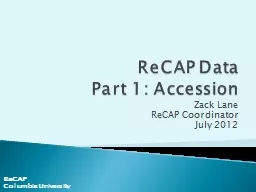

Zack Lane ReCAP Coordinator July 2012 ReCAP Columbia University An item is accessioned when it is processed by ReCAP staff and shelved at the facility Books must have a unique barcode and be in good condition ID: 775869
Download Presentation The PPT/PDF document " ReCAP Data Part 1: Accession" is the property of its rightful owner. Permission is granted to download and print the materials on this web site for personal, non-commercial use only, and to display it on your personal computer provided you do not modify the materials and that you retain all copyright notices contained in the materials. By downloading content from our website, you accept the terms of this agreement.
Slide1
ReCAP DataPart 1: Accession
Zack LaneReCAP CoordinatorJuly 2012
ReCAP
Columbia University
Slide2An item is accessioned when it is processed by ReCAP staff and shelved at the facilityBooks must have a unique barcode and be in good conditionAccession totals are tracked by both ReCAP and CULEach institution tracks parameters about accessions Granular, bibliographic data is available only from CUL
Accession Data
ReCAP
Columbia University
Slide3ReCAP accessioned it’s first book in January 2002Currently holds 9.47 million volumesModules 8 & 9 scheduled for completion by Summer 2013Larger scale transfers from CUL will resume in Fall 2013
Accession
ReCAPColumbia University
Slide4Granularity
ReCAPColumbia University
BarcodeCustomer codeDatePatron groupBIBL/HLDG/ITEM IDCLIO locationFiscal yearFormat
Publishing
d
ate
Language
Place of publication
Title
Call number
Enumeration/Chronology
Digitization status
Copyright status
Slide5ReCAPColumbia University
History of Accession
The history of CUL accessions at ReCAP can be divided into three periods:
FY02-FY04,
Load
In Phase
.
Large-scale transfer to clear onsite backlog and at obsolete off-site facilities; 500k per year
FY05-FY09,
Middle Phase
. Continued effort to clear backlog, re-purpose library space and offset collection growth; 300k per year
FY10-13,
Restrained Phase
. Slow-down a result of budget, delaying planned construction of new module; 150k per year
Slide6ReCAPColumbia University
Accession Statistics
3,726,036 accessions
since ReCAP opened in January 2002
FY10 : 209,630
FY11 : 183,324
FY12 : 173,299
Does not includes Columbia Law Library
283,626
total accessions
9,659,753 total accessions at ReCAP
Slide7CUL continually transfers collections to ReCAPAccession total only growsAdministration assigns informal quotas to each department libraryQuotas are based on both acquisition rate and space demandsTransfer projects vary from year to yearEach truckload carries approximately 5,000 booksTransfer schedule is maintained online
Total Accession by Fiscal Year
ReCAP
Columbia University
Slide8ReCAPColumbia University
Slide9Customer code is used by ReCAP to control access and delivery permissionsFollowing chart visualizes the distribution of customer codes within the yearly accession totalsTransfers occur in phases, out of department librariesEasier to view as pie chart, see following slides
Accession by Customer Code
ReCAP
Columbia University
Slide10ReCAPColumbia University
Slide11ReCAPColumbia University
Distribution of Customer Codes
Pie chart illustrates the distribution of customer codes at ReCAP
The four largest codes are:
CU: 69.6% general circulating
EV: 9.0% general circulating CJK
AR: 5.8% non-circ Avery Library
RS: 3.5% restricted RBML/University Archives
Slide12ReCAPColumbia University
Slide13CLIO location is the encoding used by CUL to manage offsite collectionsDepartments may have several offsite CLIO locationsOften several CLIO locations correspond to the same customer code
Accession by Department
ReCAP
Columbia University
Slide14ReCAPColumbia University
Slide15ReCAPColumbia University
Bibliographic Analysis
Granular, bibliographic data from Voyager is available for all Offsite collections
In general, better data since bibliographic control is so high compared to on campus collections
It allows analysis based on single or multiple parameters
E.g. distribution of publication dates, format and languages
Slide16ReCAPColumbia University
Format
Format is a combination of two elements of the Leader field: Type and BLvl
OCLC definitions:
Type “a” is
“Language
material”
BLvl “m” is “Monograph/item”; “s” is “Serial”
Monographs and Serials are identified by formats “am” and “as”
All other formats fall under the heading of “Everything Else”
Slide17ReCAPColumbia University
Slide18ReCAPColumbia University
Publication Date
Monographs : all records with format “am”
Only include complete dates 1850-2010
Substantial holdings of monographs published between 1950 and 1990
Post-2003 materials were transferred directly to ReCAP at the time of acquisition
Approximately 30,000 new acquisitions per year are sent directly to ReCAP
Recent publications have a high request rate
Slide19ReCAPColumbia University
Slide20ReCAPColumbia University
Slide21ReCAPColumbia University
Language
Distribution by language includes all items
424 total languages
Top ten language in ReCAP collections
English : 49.9%
German : 7.8%
Japanese : 5.5%
Chinese : 5.4%
French : 5.2%
Spanish : 3.9%
Russian : 3.8%
[none] : 2.4%
Italian : 2.1%
Korean : 1.4%
Slide22ReCAPColumbia University
Slide23More information and data can be found on the ReCAP Data Center Website includes more information about system-wide data and special projectsTailored data sets and analysis will be provided to staff via the ReCAP CoordinatorPlease see the main ReCAP website for general information about CUL procedures and systems
More Data Available
ReCAP
Columbia University
Slide24